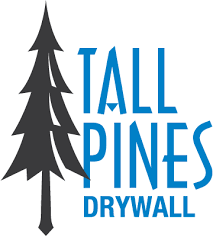Types of Drywall
A common misconception about drywall is there is only one kind: you install it and you are good to go. This is not the case. Professionals use many different types of drywall for different commercial and residential projects. Very basically, drywall is made by sandwiching gypsum between two sheets of heavy paper. The thickness of the gypsum, paper, and varying chemical additives determine what type of drywall it is.
Here are a few different types of drywall that can help determine which best suits your needs. Always remember, if your drywall is damaged from an issue such as a water leak, make sure you address that problem first before replacing the drywall.
Tall Pines Residential Living Room Project
Regular Drywall
This is the most common type of drywall you see in most family homes’ walls and ceilings. This drywall typically comes in 4 x 8 foot sheets but is available in lengths up to 16 feet for homes with higher ceilings and commercial work. If you have a small repair, most box stores sell 2 x 2 foot squares.
Look up from your phone! Chances are moisture/mould resistant drywall is used in your bathroom
Moisture/Mould Resistant Drywall
Moisture and Mould Resistant Drywall is used in areas of your home or office that due to water usage or environmental conditions that cause period elevated humidity levels, moisture vapour and dampness. Bathrooms, kitchens, laundry rooms, utility areas, mechanical rooms and locker rooms are all examples where this drywall can commonly be found. Fiberglass mesh replaces paper for the facing and backing, which eliminates food sources mould needs to grow.
Use fire resistant drywall to protect your family and office team members.
Fire Rated Drywall
This type of drywall is 5/8” thick using chopped fiberglass at its core and takes about an hour to burn through - allowing more time to escape in case disaster happens. Certain areas are required to use fire rated drywall and be up to code. The walls between your garage and your home is highly flammable if you store gasoline in there. Your basement walls use it because this is where furnaces typically get installed.
There are two types of fire rated drywall, type X and type C, the latter being considered an improvement on the former. Type C makes use of more fiberglass which increases its fire resistant qualities.
Call Tall Pines Drywall today for all your commercial and residential project needs.
Plasterboard/Blue Board
Plasterboard is commonly found in old homes and is much harder and thicker than drywall. Most commonly, plasterboard has a thickness of 9mm to 12.5mm, but you can get other variations when needed for other spaces from box stores. Benefits of plasterboard include it being a good sound barrier, it provides a smooth finish to decorate, and it is lightweight and easy to install. As a bonus, it is also 100% recyclable.
Abuse Resistant Drywall
This type of drywall is installed in areas where regular drywall can be damaged easily. High traffic areas, garages, workshops and mudrooms are all examples of where this type of drywall can be found. These panels can have up to five times the resistance of regular drywall achieved through higher wallboard density and fiber mesh being embedded in the backside of the wallboard.
Flexible Drywall
What do you do about curved walls, archways, stairways and ceilings? Flexible drywall. This type of drywall has a heavier face paper and stronger liner paper than regular 1/4” drywall does. Flexible drywall is easier to bend and is more resistant to cracking caused by structural changes.
Lightweight Drywall
You can now get a new 1/2” drywall which weights about 41 pounds, compared to regular drywall which weighs about 60 pounds. Since lightweight drywall panels have a higher strength to weight ratio than regular drywall, it is commonly used to prevent sagging in ceilings. You will not see any difference aesthetically – lightweight drywall looks, cuts, installs and finishes the same as regular drywall.
Tinfoil is laminated onto foil backed drywall.
Foil Backed Drywall
This type of drywall uses aluminum foil – the same aluminum foil you use for leftovers – on the bck of the panels. This creates a vapour barrier and adds to the insulation value which makes it most commonly used in colder climates like Winnipeg. This type of drywall can be used over wood and metal framing, as the base layer for multi-layer applications, or over furred masonry.
Call Tall Pines Drywall Today
Consider these different types of drywall when researching how you want to attack your next home or office improvement project. Take a look at our residential and commercial project galleries, and give us a call today for a free quote if you want your job done professionally!





